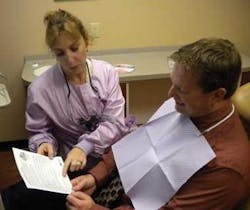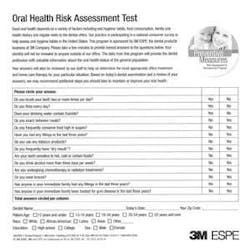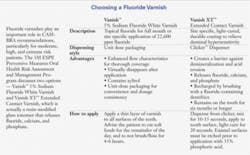Caries Risk Assessment
Simple but important steps for hygienists
by Debbie Seidel-Bittke, RDH, BS
Much of our time as dental hygienists is focused on caring for patients' periodontal health, with an emphasis on calculus removal and prevention of periodontal disease. However, there is a growing push for the hygiene community to become more actively involved with caries prevention, beyond the typical practices of home-care instruction and evaluation. Several years ago, dental professionals began organizing the outlines of what would become known as Caries Management by Risk Assessment (CAMBRA). The CAMBRA protocols represent a shift for the dental profession, from simply treating caries to actively working to prevent it by addressing its bacterial cause. Through learning about CAMBRA and implementing its recommendations in their offices, dental hygienists have a valuable opportunity to help patients take charge of both their caries control and periodontal health.
CAMBRA began taking shape in 2003 after the publication of two special issues of the Journal of the California Dental Association, calling for dental professionals to adapt their caries strategies to address bacterial causes as well as “remineralization and repair of early lesions.”1 An updated consensus statement was issued in 2007, renewing the call for dental professionals to focus on “modification of the oral flora, patient education, remineralization, and minimal operative intervention.”2 By reframing caries as a “curable and preventable” disease, CAMBRA encourages the dental team to expand its practice beyond simply detecting and filling cavities.3
How risk assessment works
The “risk assessment” in CAMBRA is grounded in the use of a Caries Risk Assessment Form, which practitioners are instructed to use to evaluate each patient's disease indicators, risk factors, and protective factors to determine their level of caries risk. Several incarnations of this form exist, but the California Dental Association's (CDA) is likely the most well known. The form lists 24 factors that dental professionals can use to evaluate patients' level of risk, from disease indicators such as white spots on smooth surfaces to protective factors such as living in a fluoridated community. The form organizes the questions in a way that makes scores easy to visualize and tabulate. A separate form for pediatric patients adapts these items into a format for parental questioning and clinical examination.
Based on the results of the assessment form, the dental team is able to easily divide patients into categories of low, moderate, high or extreme risk, and then make informed recommendations for helping each patient prevent caries and manage existing issues. The clinical guidelines published by the CDA outline recommendations for each group of patients regarding:
- Frequency of radiographs
- Frequency of caries recall exams
- Saliva testing
- Use of antibacterials, chlorhexidine, and xylitol
- Fluoride
- pH control
- Calcium phosphate topical supplements
- Sealants4
If the assessment form reveals that the patient is at high risk for caries, CAMBRA protocols suggest a number of steps the dental team can take to better treat that patient and reinforce their preventive efforts.
After identifying a high-risk patient, the hygienist reviews proper toothbrushing instructions with the patient, and provides additional instructions on prescription-strength home-care products, such as toothpaste (for example, Clinpro™ 5000 1.1% Sodium Fluoride Anti-Cavity Toothpaste) and fluoride gel. This is the appointment where a fluoride treatment becomes highly beneficial to the patient on a frequent basis. Patients are instructed to return to the office every 12 weeks for a brief reassessment. This visit includes assessment of the biofilm, saliva tests, oral hygiene review and oral hygiene instructions as necessary, and an application of fluoride varnish (for example, Vanish™ 5% NaF White Varnish, or Vanish™ XT Extended Contact Varnish — a resin-modified glass ionomer that releases fluoride, calcium, and phosphate; both products are from 3M ESPE) (see comparison sidebar). With this protocol, patients alternate between their regular six-month appointment and the shorter reassessment and fluoride varnish appointments, allowing the office to check their progress more frequently and identify any new issues early. In my experience, this recall schedule works very well to help control caries in moderate- to high-risk patients.5
Compliance is obviously an important concern when treating moderate- and high-risk patients, since poor home care is often a contributor to the problem. The financial demands of restoring carious lesions can often be a strong motivator for patients to improve their compliance. Patients realize that using a prescription toothpaste and various other home-care products to prevent additional caries is much more financially manageable than continually paying for restorative work. Furthermore, many insurers now have coding for the 12-week reassessment appointments recommended by CAMBRA. Therefore, the increased level of care often does not result in significantly increased costs to the patient.
New tools to jump-start implementation
Despite mounting clinical evidence demonstrating the usefulness and effectiveness of CAMBRA, the guidelines have yet to be adopted in many dental practices. For hygienists, however, CAMBRA represents a valuable opportunity to help build the practice and take leadership of an important issue. The CDA has published recommendations for the hygienist's role in initiating CAMBRA protocols, emphasizing that “hygienists are knowledgeable and prepared to contribute to risk assessment through the development of office protocols, the creation of patient literature, and the expansion of treatment recommendations.”6
As recognition grows for the importance of CAMBRA, new tools are being developed to assist hygienists in implementing its principles.
One such tool is the Preventive Measures Oral Health Risk Assessment and Management Program from 3M ESPE Preventive Care. Modeled on CAMBRA practices, the program seeks to help dental professionals quickly and simply establish a formal risk assessment program in their offices, and provides them tools to help initiate this transition. An introductory kit for the program from 3M ESPE includes several components that can help hygienists and the entire dental team to implement CAMBRA guidelines. These include a reception area easel to educate patients about the program, a self-administered oral health risk assessment for patients, a chairside treatment guide, and a reference poster that lists treatment protocols and accompanying product recommendations.
The risk assessment test is an important step in helping adult patients take stock of their oral care habits.
While it is not intended as a replacement for the more formal risk assessment forms offered by the CDA, it is a simple tool to introduce the topic of caries management to patients and trigger a meaningful conversation about caries risk factors. The test asks 14 yes-or-no questions and organizes patients' answers into columns that let them easily compare their positive and negative caries risk factors. Encouraging patients to complete this test can be a simple way to help them take ownership of their oral health habits.
The chairside treatment guide, included in the program from 3M ESPE, is an extremely helpful tool. The guide is a small two-sided wheel that helps not only the hygienist but anyone of the dental team to easily reference CAMBRA and ADA guidelines according to patients' risk levels. One side of the wheel includes information on recommendations for pediatric and adult caries prevention, sensitivity prevention, and periodontal prevention. The second side of the wheel displays products that can be used for each component of treatment. With this tool, hygienists can easily assess patients with the written questionnaire and a visual exam, and then use the wheel to arrive at a treatment plan, picking and choosing the most appropriate recommendations.
Moving our practices forward
Dental technology and treatments have advanced to a point where it is more possible than ever to help patients aggressively address problems with caries, and CAMBRA principles help dental professionals determine the most appropriate steps to achieve that. Hygienists have an important responsibility, as well as a valuable opportunity, to utilize CAMBRA recommendations to help their practices advance in providing the best care for patients. By learning more about caries risk assessment and utilizing the available tools for implementing it in our offices, we can make significant progress in helping our patients fight and prevent caries.
For more information on the 3M ESPE Preventive Measures Program, contact 3M ESPE Customer Care at (800) 634-2249, or visit www.3MESPE.com/PreventiveCare.
Debra Seidel-Bittke, RDH, BS, is founder of Dental Practice Solutions, an international coaching/consulting and education firm. Debbie graduated from the University of Southern California in 1984, and then worked as a clinical assistant professor for many years at USC. Most recently, Debbie authored the initial accreditation for a new dental hygiene program in Portland, Oregon. In addition to lectures and workshops, her consulting business has implemented the Dental Practice Solutions curriculum in many practices throughout the nation. Visit her Web site: www.dentalpracticesolutions.com for more information on weekly webinars and future courses.
References
- Featherstone JDB. Cariology in the new world order: moving from restoration towards prevention. J. Calif. Dental Assoc. Feb 2003.
- Young DA, et al. Caries management by risk assessment: implementation guidelines. J Calif Dent Assoc. 2007 Nov;35(11):799-805.
- Young DA, et al. New Directions in Interorganizational Collaboration in Dentistry: The CAMBRA Coalition Model. J Dent Educ. 71(5): 595-600 2007.
- Jenson L, et al. Clinical protocols for caries management by risk assessment. J Calif Dent Assoc. 2007 Oct;35(10):714-23.
- Evidence-based clinical recommendations. American Dental Association Council on Scientific Affairs. JADA Vol 137. 2006 August.
- Gutkowski S, et al. The Role of Dental Hygienists, Assistants, and Office Staff in CAMBRA. J Calif Dent Assoc. 2007 Nov;35(11):786-793.



